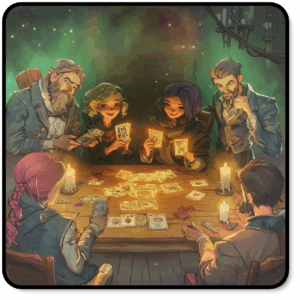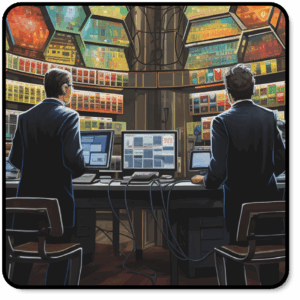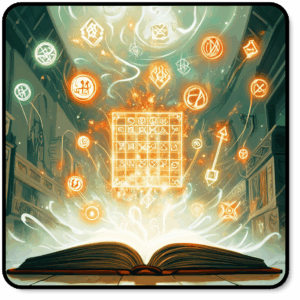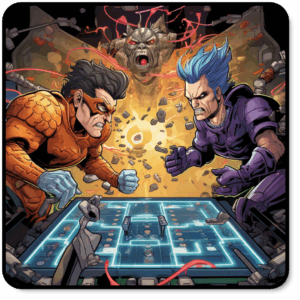

















Hackers
Mechanics
Mancala • Take That • Turn Order: Progressive
Game Overview
Core Concept:
- Hackers is a 2–5 player game where players become elite Hackers attempting to breach rival firewalls and take over their core systems.
- Using a unique twist on the classic Mancala mechanic, players gather blocks of code and choose between attacking their rivals or developing powerful Hacker Tools.
Key Systems:
- Shared Mancala Network:
- Players control a looped network of three spaces each on a shared board. On their turn, they pick up all code blocks from one space and redistribute them clockwise, one per space.
- If the final drop lands on a space with matching color blocks, all are collected.
- Landing on an empty space earns a bonus turn.
- Collected blocks are then used to either attack opponents’ firewalls or create Hacker Tools. The shared network constantly shifts, requiring timing and prediction.
- Hacker Tools (Color-Coded Abilities):
- Purple: Collect blocks based on the first space seeded, not the last.
- Yellow: Sow blocks counter-clockwise instead of clockwise.
- Blue: Remove up to 3 blocks from any one space in your network.
- Green: Swap contents of two spaces within your network.
- Orange: Swap a space in your network with a weaker external one.
- Players can also spend 2 Hacker Tools to heal their firewall or 3 Hacker Tool to relocate their entire network.
- Viruses (Unstable Code Blocks):
- Starting in Round 2, brown Virus blocks are mixed into the supply bag and placed on the board like normal code.
- Virus Special Rules:
- Viruses must be placed first during distribution.
- When placed, they automatically attack the player by transferring one block of that color from the target space to the player’s firewall.
- If 3+ viruses land in one space, all blocks there are wiped from the game.
- Hacker Tools offer key methods for virus manipulation or removal.
- End-of-Turn Network Refill:
- After each player’s turn, a Network Card is drawn, identifying three networks to replenish.
- Spaces with 0–2 blocks are filled from the bag up to 3 (introducing possible Viruses).
- Spaces with 3+ blocks are skipped.
Design Principles:
- Combo-Driven Tension: Every turn is a puzzle of movement, timing, and opportunity. Players chase clever, chain-reactive plays while watching their own firewall crumble.
- Constant Player Interaction: Attacks are relentless and direct — players can’t opt out of engagement. Defense, prediction, and retaliation shape every decision.
- Evolving Replayability: Randomized code block placement and flexible Hacker Tool combinations ensure no two games unfold the same way. Strategic adaptation is essential.
Endgame Structure:
- Instant Trigger: The game ends immediately when any player’s firewall board is completely filled. There is no final round — the breach ends it all.
- Victory Condition: The winner is the player with the least filled board, regardless of who triggered the end. A well-timed final attack can backfire if it hands the win to a rival with stronger defenses.
- Strategic Tension: Players must decide when to press the attack and when to stall — sometimes letting an opponent survive keeps another from winning.
Future Expansion Ideas:
- Asymmetrical Hacker Roles: Introducing unique player abilities to shift strategies and further differentiate playstyles.
- Expanded Hacker Tools: Designing new color-coded effects to deepen decision space and unlock advanced tactics.
- Cyber Police: A proposed system that introduces external interference, punishing over-aggression or enforcing shifting objectives.
